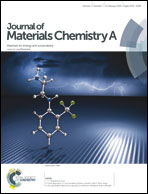Fabrication of metal-oxide-free CH3NH3PbI3 perovskite solar cells processed at low temperature†
Abstract
Efficient metal-oxide-free perovskite solar cells were successfully developed by employing the N–I–P architecture. The modified solvent engineering process employing a diethylether drip as an orthogonal solvent enabled fabrication of a multi-layered device comprising FTO/PEI/PCBM/MAPbI3/PTAA/Au at low temperature (≤100 °C). Optimization of the thickness of the phenyl-C61-butyric acid methyl ester (PCBM) layer in the planar device yielded an overall power conversion efficiency (PCE) of 15.3% with a large hysteresis but a steady-state efficiency of 13.9% under AM 1.5G 100 mW cm−2 illumination. The use of the low-temperature processed dense-TiO2 layer in conjunction with the PCBM layer gave rise to performance comparable to that of the single electron transport layer (ETL) device and enabled fabrication of an efficient, flexible perovskite solar cell with a PCE of 11.1%.


 Please wait while we load your content...
Please wait while we load your content...